By Eric Vandenbroeck
and co-workers
The Situation Ukraine Is Facing This
Winter
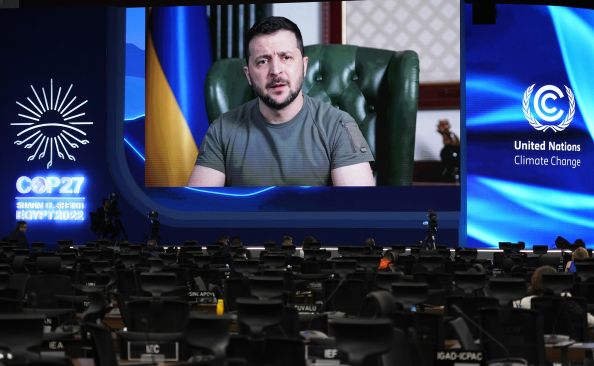
Since mid-October,
Russia has repeatedly targeted civilian air and missile strikes against civilian
targets. Over the past
several weeks, infrastructure across Ukraine has been taking out the Ukrainian
economy's vital organs. The man newly in charge of Russian forces in
Ukraine—General Sergei Surovikin, so ruthless that
even his colleagues call him “General Armageddon”—has shown no signs of
relenting. Russia has successfully attacked 40 percent of Ukraine’s power grids
with missiles and Iranian drones. It has bombed energy facilities, including
hydroelectric dams, leaving more than one million
Ukrainians without
electricity. In Kyiv, 80 percent of residents are without water, according to
the city’s mayor. Economists project that Kyiv’s economy will
shrink by at least 35 percent in 2022, and the United Nations
estimates that nine of ten Ukrainians could be impoverished by Christmas.
Men carry boxes with humanitarian aid in the recently
retaken town of Izium, Ukraine.
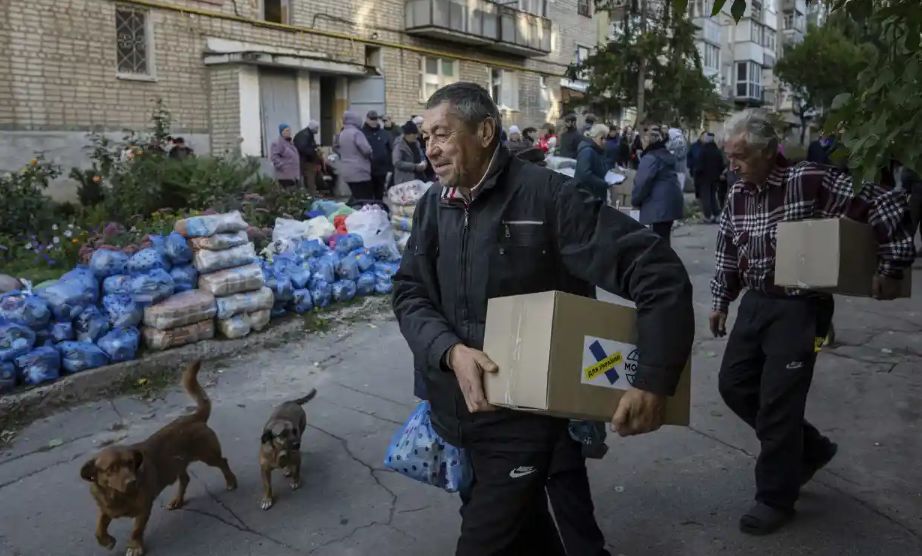
For the West, the
recent attacks should invite a sense of déjà vu. In 1948, Soviet leader Joseph Stalin blockaded the western sector of Berlin,
controlled by the United States and its allies, as part of his plan to ultimately
dominate a unified Germany. The Soviets cut off all access to the city by rail,
canal, and road, inflicting tremendous hardship on West Berlin. But the United
States and the United Kingdom quickly responded to the Berlin blockade with
what came to be known as the Berlin airlift, flying in food, coal, and other
necessities to the besieged city and successfully foiling the Soviets’ cruel
plan. By May 1949, Stalin had lifted the blockade, and the Federal Republic of
Germany was founded the same month. The West won early in the Cold War, thanks
to its unwavering stance.
Ukrainians cross an improvised path under a destroyed
bridge
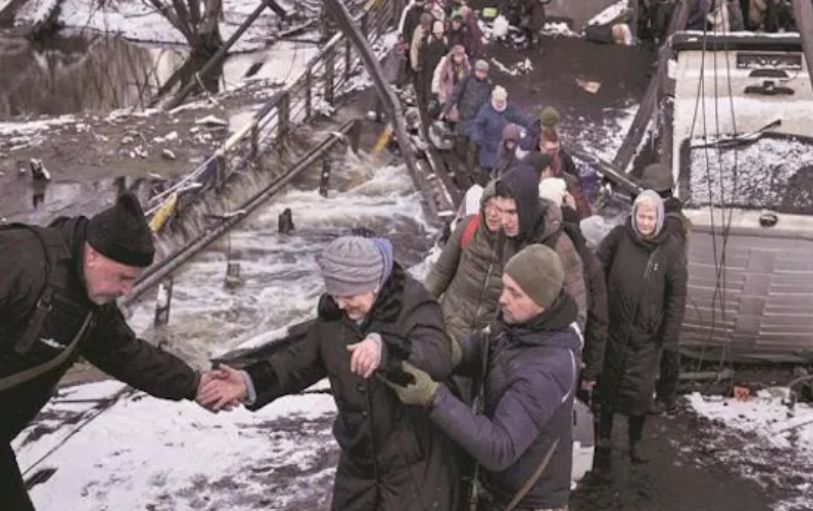
Today, as Russian
President Vladimir Putin seeks to subjugate Ukraine, the West
is facing a new Berlin blockade moment. It should channel the same
determination to prevent Putin from destroying Ukraine that it mustered with
the Berlin airlift. The United States and Europe must act now to ensure that
Ukraine survives the winter by adopting various measures, including additional financial
assistance, equipment to restore power and heat, and air defense systems to
protect Ukraine’s infrastructure from the continued onslaught of Russian
missile strikes. Sufficient aid to Ukraine will ensure that the country can
emerge from a daunting winter battered but primed for recovery, just as West
Berlin did in 1949.
Send Lawyers, Guns, And Money
The money the West sends
to Ukraine is just as important as the weapons systems being delivered. Absent
the injection of $8.5 billion from Washington, Ukraine would have gone bankrupt
overnight. Thanks in part to such aid, the country’s banking system, railways,
and hospitals continue to function. Eight months into the war, Kyiv promptly paid state salaries and pensions. But
it confronts a budget deficit of $5 billion to $6 billion each month, forcing
Ukraine’s Ministry of Finance to scramble to ensure that state services are not
threatened.
Russian President Vladimir Putin with then-PM Dmitry
Medvedev and Sergei Surovikin in 2017
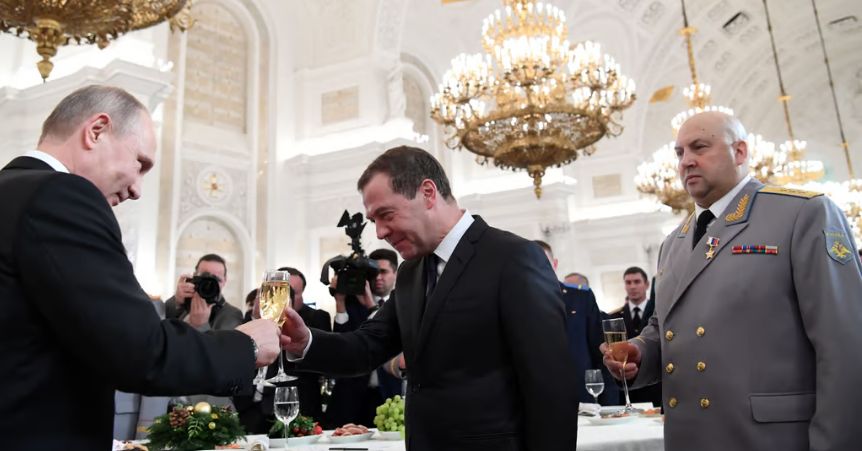
The EU committed to
sending $9 billion in loans in May 2022 but is
dragging its heels on sending a final tranche of $3 billion. It will likely
only arrive next year. The public pledges are there, but the willpower has been
wanting. At a G7 meeting in early November, German Foreign Minister Annalena Baerbock stated, “We
will not allow the brutality of this war to lead to masses of elderly people,
children, young people, and families dying in the coming winter months.” In
October, Christian Lindner, Germany’s finance minister and a budget hawk,
denied that Berlin is slow-rolling funding.
Withholding or
slowing the transfer of funds heightens the danger that hyperinflation in
Ukraine could ignite. A shortage of funds has prompted the central bank to
increase the money supply by purchasing billions in government bonds, thereby
eroding the value of the country’s currency, the hryvnia. In September,
Ukraine’s inflation rate rose to almost 25 percent. Hyperinflation would make
it even harder for the Ukrainian state to stay afloat, let alone successfully
prosecute the war.
The EU is
contemplating a further $18 billion transfer for 2023, but whether it will come
through is an open question. With Germany in particular, there has been a
marked difference between what it promises publicly and what it delivers. The
EU’s pledged support plus a potential new $10 billion infusion of funds for the
next two years from the International Monetary Fund would help to remedy Kyiv’s
immediate financing gap, which is several billion a month. Since the conflict
began in February, the U.S. Congress and the Biden
administration have regularly dispatched vital defense and financial
packages.
Alas,
as Ukraine enters the winter, already without power and in the dark,
support in the United States is starting to buckle. In September, almost all
House Republicans voted against a funding bill that contained $12 billion for
Ukraine. Kevin McCarthy, the leader of the Republican minority in the House,
recently warned that should the GOP win control of the House, it will refuse to
write Ukraine a “blank check.” At a campaign rally in Sioux City, Iowa, on
November 3, Representative Marjorie Taylor Greene, a Georgia Republican who is
a frontrunner for a leadership position in a new Congress, declared: “Under Republicans,
not another penny will go to Ukraine. Our country comes first.” Indeed, a
new Wall Street Journal poll indicates that while most Americans continue to back aid
to Ukraine, the number of Republicans who believe America is granting excessive
support has rocketed to 48 percent. And with the current mid-term elections,
this has become even worse:

Maintaining US
subventions will be difficult, considering the Republicans win control of
the House of Representatives. Yet compared with the massive budget outlays for
the U.S. Defense Department, the aid to Ukraine is not only modest but
something of a bargain. For the fiscal year 2022, Congress appropriated $728
billion for the Pentagon. Meanwhile, it has committed over $18 billion in
security assistance to Ukraine since the war began in February. The result of
that spending is that Russia has been significantly weakened. Its ignominious
defeats on the battlefield have rendered hollow its pretensions to great-power
status, dramatically magnifying the relative military power of the United
States almost overnight.
Rep. Victoria Spartz surveys
damage to buildings in Bucha, Ukraine, on April 14, 2022.
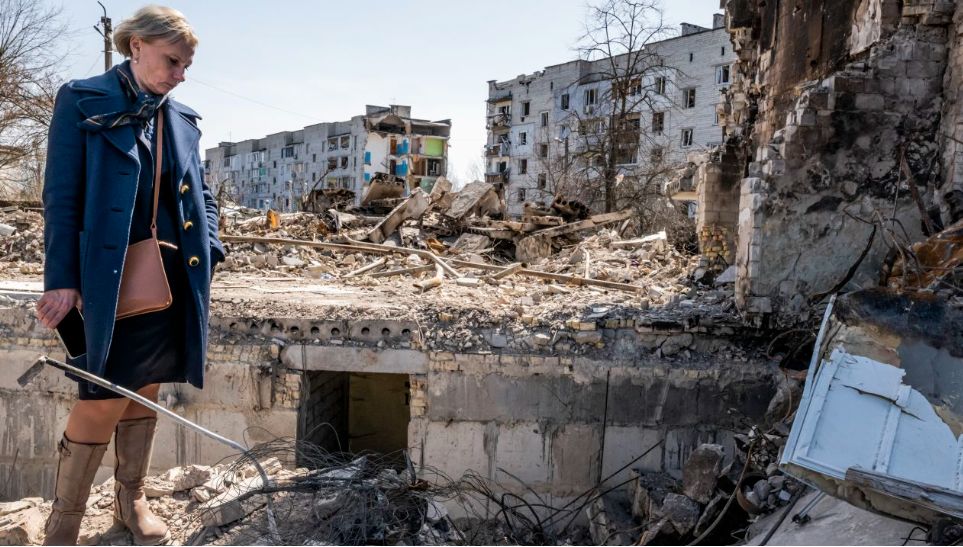
Some Republicans,
such as Victoria Spartz, the Ukrainian-born Indiana
congresswoman, have raised
the specter of corruption in Kyiv. There can be no doubt that the Ukrainian
government has a long history of speculation, but in the case of budgetary
support during the war, it has worked hard to be a good citizen.
This year, for example, Ukraine’s Ministry of Finance has opened its books to
the financial consulting company Deloitte. For months, its auditors have been
embedded in the ministry and oversee funds as they are transferred, ensuring
they are spent as intended and not stolen. In addition, most U.S. funds are
being provided on a reimbursement basis, minimizing the risk of fraud and
embezzlement. Given the conspicuous lack of evidence of fraud, arguments
against sending aid citing Ukrainian corruption are nothing more than
convenient excuses to do nothing and let Moscow triumph.
Leave A Light On
Money is scarcely the
only problem confronting Kyiv. Moscow’s attacks on Ukraine’s energy
infrastructure have led to blackouts. The government is requesting that its
citizens voluntarily turn off their electricity and mandating rolling
blackouts, thereby reducing the demand for power stations so they can be
repaired appropriately. By and large, the public is complying. When Russia
launched a barrage of missile strikes on October 10 in retaliation for the
bombing of the Kerch Strait Bridge, which connects the Crimean peninsula to
Russia, Kyiv residents rushed to gas stations to fill their tanks, but there
was no mass panic.
The Kremlin hopes
that through its bombing campaign, it can weaponize refugees, provoking a fresh
exodus to Poland and elsewhere this winter. This would be a recipe for stirring
up political turmoil and emboldening far-right parties, many of whom are
sympathetic to Putin. Already German cities, for example, are overstretched in
absorbing an influx of over one million refugees from Ukraine. The refugee
crisis is the biggest Europe has witnessed since the end of World War II. Right
now, however, Ukrainians remain defiant: Oksana Nechyporenko,
a prominent civil society leader, told us that no one is panicking but that her
friends with children are searching for safer places in Ukraine to live during
the winter. Nechyporenko lives on the 14th floor of
an apartment building in Kyiv, and the periodic blackouts mean that she must do
the exhausting 20-minute climb up the stairs to her door each time she returns.
Since the missile strikes began on October 10, schools have
reverted to teaching remotely, a particularly unfortunate development given
that 3,000 of Ukraine’s schools could reopen on September 1 after being closed
since February.
“Putin doesn’t have
to use nukes to cause a catastrophe,” said Victoria Voytsitska, the former chair of the Ukrainian
Parliament’s energy committee, during an October interview with us in
Washington, D.C. “It’s impossible to protect Ukraine’s heating system.” Voytsitska, like Ukrainian President Volodymyr Zelensky,
has been urging the West to send air defense systems to Ukraine as soon as
possible. The damage Russia has inflicted since mid-October has been extensive.
Half of the population in Chernihiv, a city in Ukraine’s north, lacks water
because it requires electricity to pump and deliver it.
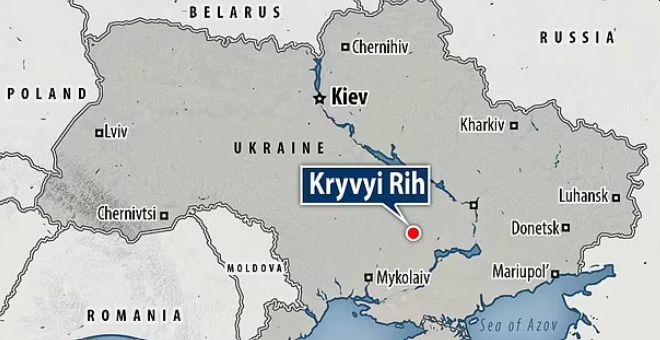
In Zelensky’s
hometown of Kryvyi Rih in central Ukraine, Moscow has repeatedly hit a dam,
causing residents to evacuate their homes in case the area floods. In
Zaporizhzhia, in the southeast, half of the city doesn’t have heat. Voytsitska urged donors to invest in “warming shelters,”
safe public rooms in cities and towns where residents can stay 24 hours a day
when temperatures plunge, and there is no heat or power. She’s also worried
about what might happen if Russian missiles hit hospitals: patients could be
left to freeze to death. Voytsitska’s worries are not
theoretical. In March, for example, 300 Ukrainians froze to death in Chernihiv.
In the short term,
the West can help Ukraine repair its electrical grid. Already, Lithuania is
sending technical parts—mostly transformers and electrical cables— to repair
power generation stations. Many urgently needed parts require a long wait, so
Western countries can prod the companies that manufacture them, such as
Siemens, to put Kyiv at the head of the line. But even if some of Ukraine’s
heating systems can be repaired, Moscow will attack again and again. According
to the investigative news outlet Bellingcat, a secret military unit composed of 33 engineers
based in Moscow is carefully directing the Kremlin’s targeting of Ukraine’s
civilian infrastructure.
Ultimately, sending
air defense systems is the best way to protect Ukraine’s energy systems and its
civilian population. Five months ago, Germany pledged to send four systems but
has only delivered one: an IRIS-T air defense system, which provides
medium-range, high-altitude protection for small cities. The rest are expected
to be delivered in the new year. Air defense systems are complex, expensive,
and in high demand, but Ukraine is in dire need of them. Kyiv has officially
asked Israel for a number of these systems. It is high time for Israel to end
its neutral posture on the war and start supplying Ukraine with the weapons it
needs, including Israel’s vaunted Iron Dome and technicians to train Ukrainians
on how to use them. For its part, the United States is trying to speed delivery
of two advanced surface-to-air missile systems, with six more coming
later.
As Putin seeks to
pound it into submission, Ukraine continues to advance on the battlefield, and
its troops’ morale remains high. But for the country to survive the winter, the
butter will be as important as guns. A spell of warm weather and abundant
imports mean that European gas storage facilities are over 90 percent full,
ensuring that fuel prices in Europe have also plummeted. So far, Putin’s
attempts to bully Europe on the energy front are failing as miserably as his
military adventure. But Putin continues to hope that the Western public will
tire of the conflict and push their governments to concede to his demands.
However, for Washington and its allies, failure in Ukraine would mean confronting him again on another European battlefield.
The faster the West aids Ukraine, the more quickly
it can stymie Putin’s ambitions.
Kherson
On a more positive
word today, Ukraine pushes Russia out of Kherson, the most significant
liberation yet. But even though Ukrainian troops are still raring to
advance in the frigid temperatures, intelligence officials remain wary of the
situation in Kherson, which is believed to be heavily mined by departing
Russian troops, a tactic that dates back to the Second World War and one that
has been used heavily in the full-scale invasion of Ukraine to sow death and
dismemberment for Ukrainians returning. The Ukrainian military official
said troops would have to wait to seize the city until it was relatively clear
of mines and booby traps.
More U.S. help may
also have to wait. On Tuesday, Colin Kahl, the Pentagon’s policy chief, told
reporters that arming Ukraine had begun to take a toll on Western ammunition
stockpiles. There’s also been no signal from the Biden administration that the
longer-range U.S. Army Tactical Missile System, which can be fired from
truck-mounted HIMARS cannons, is coming any time soon, even as Congress could
push for more than $50 billion in aid to Ukraine during the lame duck.
Still, with more of
the country back in Ukrainian hands, officials in Kyiv today were breathing
easier about haggling with Western officials over military aid.
Kherson city was the
only regional capital Russia had captured since its invasion in February. The
abandonment of such a strategic prize would be a significant
setback for Moscow's
“special military operation” in Ukraine.
For updates click hompage here